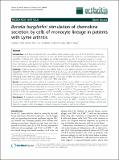| dc.description.abstract | Introduction: Joint fluid in patients with Lyme arthritis often contains high levels of CCL4 and CCL2, which are chemoattractants for monocytes and some T cells, and CXCL9 and CXCL10, which are chemoattractants for CD4+ and CD8+ T effector cells. These chemokines are produced primarily by cells of monocyte lineage in TH1-type immune responses. Our goal was to begin to learn how infection with Borrelia burgdorferi leads to the secretion of these chemokines, using patient cell samples. We hypothesized that B. burgdorferi stimulates chemokine secretion from monocytes/macrophages in multiple ways, thereby linking innate and adaptive immune responses. Methods: Peripheral blood mononuclear cells (PBMC) from 24 Lyme arthritis patients were stimulated with B. burgdorferi, interferon (IFN)-γ, or both, and the levels of CCL4, CCL2, CXCL9 and CXCL10 were measured in culture supernatants. CD14+ monocytes/macrophages from PBMC and synovial fluid mononuclear cells (SFMC) were stimulated in the same way, using available samples. CXCR3, the receptor for CXCL9 and CXCL10, and CCR5, the receptor for CCL4, were assessed on T cells from PBMC and SFMC. Results: In patients with Lyme arthritis, B. burgdorferi but not IFN-γ induced PBMC to secrete CCL4 and CCL2, and B. burgdorferi and IFN-γ each stimulated the production of CXCL9 and CXCL10. However, with the CD14+ cell fraction, B. burgdorferi alone stimulated the secretion of CCL4; B. burgdorferi and IFN-γ together induced CCL2 secretion, and IFN-γ alone stimulated the secretion of CXCL9 and CXCL10. The percentage of T cells expressing CXCR3 or CCR5 was significantly greater in SFMC than PBMC, confirming that \(T_H1\) effector cells were recruited to inflamed joints. However, when stimulated with B. burgdorferi or IFN-γ, SFMC and PBMC responded similarly. Conclusions: B. burgdorferi stimulates PBMC or CD14+ monocytes/macrophages directly to secrete CCL4, but spirochetal stimulation of other intermediate cells, which are present in PBMC, is required to induce CD14+ cells to secrete CCL2, CXCL9 and CXCL10. We conclude that B. burgdorferi stimulates monocytes/macrophages directly and indirectly to guide innate and adaptive immune responses in patients with Lyme arthritis. | en_US |


